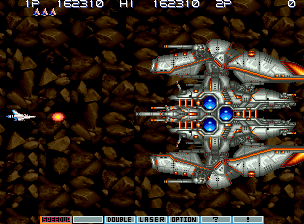

The vast dungeons are complex mazes with false walls and hidden doors at every turn. Typical for the era, Drasle Family gives players very little direction.

Like many games in the series, Drasle Family is a side-scrolling adventure game with a vast open world design not unlike what you’d expect to see in a Metroid game.
Gradius 2 boss words series#
The scrolling in Gradius 2 is pretty choppy and somewhat distracting, but that’s pretty much par for the course on the MSX.ĭrasle Family is the fourth entry in Nihon Falcom’s iconic Dragon Slayer series of action-RPGs. The main stages themselves are well-designed and feature a variety of interesting locations ranging from plant-based worlds to LifeForce-inspired organic planets that make you feel like your flying through intestines. Gradius 2 features more boss encounters than the first game and gives players the opportunity to fly into their cores after defeating them for a chance to earn new weapons in a mini-stage. There are also additional power-ups to obtain outside of your standard weapons that allow players to do things like slow down time or drill through certain obstacles. Gradius 2 follows the same basic formula established in the original game, but it includes a host of interesting new power-ups – including a cool boomerang-inspired wave. Gradius II landed in arcades in 1988, but the unrelated MSX version of Gradius 2 hit store shelves the previous year. The game was first released in arcades in 1985 and ported to dozens of platforms. Gradius is a side-scrolling shooter best known for its innovative “weapon bar” power-up system that gave players control over how their ship was upgraded after collecting power-ups. At the risk of spoiling the rest of this list, it’s a safe bet that several Konami games will show up. No game developer was more closely associated with the MSX than Konami. Guardic wasn’t necessarily as ambitious as some of Compile’s other games, but it was a unique take on a genre that was as old as video games themselves. Players also encounter friendly characters in battle who can provide them with special abilities. Players navigate through a maze as they move from one battle to the next and are given control over which path they take. A light RPG influence can be seen in the game.

Giving yourself maximum energy for your weapons will make taking down enemies easier, but you will be left with less energy for subsequent battles. It’s necessary to re-equip weapons before every battle, so some strategy is required when it comes to the allocation of your energy. At the beginning of each battle, players are able to draw from their power supply in order to improve their primary weapon, increase their speeds, or select a secondary weapon. There are vast numbers of enemies to defeat and their patterns can be difficult to predict, but Guardic gives players interesting ways to dispatch them. The end result is a game that feels like a new take on Galaxian or Galaga. The background scrolls as you move from one wave of enemies to the next, but it’s static during battle. Instead of fighting enemies through lengthy scrolling levels, you are instead tasked with taking down single screens of enemies. Guardic is a little different than most Compile shooters. Games like Zanac and Aleste helped define the genre in the 1980s. When it comes to horizontally-scrolling shooters, no company had a better handle on the genre than Compile. The original Golvellius looks primitive compared to its younger brothers, but the music sure is catchy and it’s one of the deepest adventure games of its era. An MSX2 version followed and was given a similar update, but the game was different enough from the original that it is often erroneously referred to as Golvellius 2. Golvellius was originally released on the MSX in 1987 before being ported to the Sega Master System the following year with enhanced graphics and entirely different overworld and dungeon layouts. Some dungeons are played from overhead and feature forced scrolling, while others play out more like traditional side-scrollers. The dungeons are relatively linear and don’t require any puzzle solving skills, but they help break up the action and add some variety to the game. There are also plenty of items to find – including medical herbs to restore health, shields to deflect attacks, and boots that will allow you to walk on water.

There are plenty of secrets to be found throughout the game, and there’s a hidden cave in almost every screen on the overworld map. The game is played from an overhead view, features a huge world, and puts heavy emphasis on exploration. Golvellius is an adventure game from Compile that takes several cues from The Legend of Zelda.


 0 kommentar(er)
0 kommentar(er)
